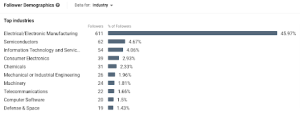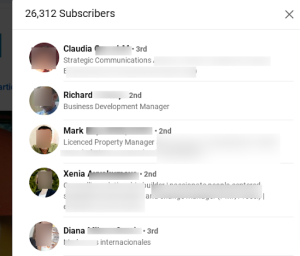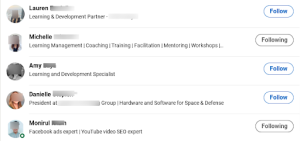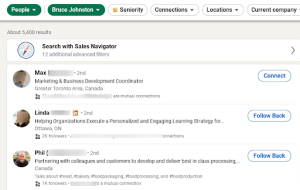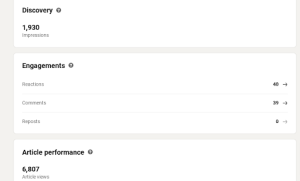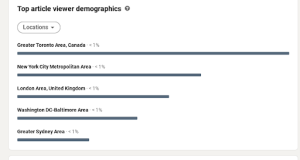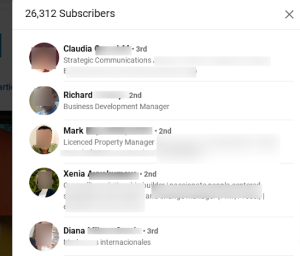All About LinkedIn Followers and Subscribers
There are three wonderful groups of people that remain a black box, a mystery: your personal followers, your corporate followers, and your subscribers. Let’s look at each type, who they are and what you can do with them.
Corporate Followers
LinkedIn members can choose to follow your company page and receive notifications when you post. Great idea. But I would like to know more about those followers, lots more. Are we attracting the right people from the right companies? Job titles? Geographies? But what LinkedIn provides us with in answering these questions is vague and incomplete.
I manage the LinkedIn company pages for a number of companies. Let me use one as an example here. They have around 1400 followers. But here is what LinkedIn tells me about them:
Note that this example is split by industry, but I could have chosen location (by city only), seniority, job function, or company size. The problem is not the data itself but the idea that it is superficial – for example top ten industries only in the example above, or that I can’t choose a country or region in the geography filter – and that I can’t correlate it. For example, my client may wish to focus on engineers in the semiconductor industry in the United States. I can see we have some followers who are in the United States, some who are Engineers and some who are in the semiconductor industry, but I can’t figure out if any of the 1400 followers meet all three criteria.
And this is all data that would help my client with their LinkedIn strategy.
Well, what about individual company followers? Can we see them? Yes, we can. Sort of.
These are the latest five who followed my client’s company page when I wrote this piece back in June (you can see “June 2023” in the right hand column). If I want to see the other 1396 followers, I just have to click on the “See all followers” and at five followers per page, I can scroll through 280 pages of them.
Oddly, the more successful you are at attracting followers, the harder it is to see and make sense of them.
So let’s move on to…
Your Personal Followers
Okay, first of all, LinkedIn does a lousy job of defining Followers and it can get confusing. If you go to your profile, under your Activity will be your number of followers. Here was mine the morning I wrote this:
However, clicking on this number shows that my followers are made up of two groups of people, my connections (who automatically follow me) and people who have chosen to follow me but have not asked to connect with me. So this leaves the odd “only on LinkedIn” equation:
Your # of connections + Your # of followers = Your # of followers
If I click on my 11,088 followers in my activity section, a list shows up.
The number of people I am following are for all intents and purposes, my connections. When you connect with someone, LinkedIn automatically considers you a follower of theirs. You do have the option of unfollowing connections, which I have done for a couple hundred of mine, mostly for the crime of manic posting and clogging up my feed (seriously, there are people I know who post twenty times a day.)
I can also see the people following me that I am not connected with, with whom LinkedIn is dangling the offer to Follow them.
Alright, so now that we know who our followers are, what can we do with them? The answer used to be not much. You could scroll through them and that’s about it.
All that changed with Creator Mode.
One of the search filters you can use in free LinkedIn search is to search the followers of individual Creators. All you have to do is specify yourself as the Creator whose followers you want to search and away you go.
Note that all I had to do was specify a people search, type in my own name as the Creator whose followers I wanted to see, and here they are.
I can then use further filters to search by geography, industry, job title and so on. This is huge and not many people have made the connection (so to speak) between having this filter and using it on their own followers.
Of course, the one pre-condition is that you have to have Creator mode turned on.
There is a further subset of your followers that we should talk about, and I will do that at the end, after this next section.
Newsletter Subscribers
If you publish a newsletter on LinkedIn you will have subscribers. What you can do with your newsletter subscribers is…not much.
Below are the stats for an issue of my newsletter (June 2023). I have the people that LinkedIn showed it to (impressions), the engagement, and the number of people who opened the newsletter. Now, if someone was shown the newsletter and then decided to read it, are they part of both the impressions and the opened numbers?
The only demographics I get on my newsletter are the individual statistics provided for the people who actually read any single issue. And those stats are pretty much the same as the ones you would see for a regular LinkedIn article. Here is what I got from one of my newsletter issues in June:
I can change locations to Company or Job Title.
There are several problems with these statistics:
- They are incomplete. One of my key demographics is company size. Companies that have ten to five hundred employees are right in my wheelhouse. That is the company size that typically can become a long term client.
- I can’t correlate them. I get a lot of Company Founders, but where are they?
- This also represents a snapshot of the people who read this single issue of my newsletter. I know that around 6,800 of my subscribers opened this issue. But as I have 26,000 subscribers, these statistics only tell me something about one quarter of my subscribers. Not really very satisfactory.
Note that all of this is typical of LinkedIn. It kind of looks good on the surface (look at all the company founders who read my newsletter!) until you try and actually figure out how you can use that information (where were those founders located? Why don’t I have a list of them?(
I can access the list of my subscribers. Here is what it looks like:
You will notice that I can see five to six people on this first page. So if I wanted to review my subscribers, all I have to do is page down around five thousand times.
Not good.
Special Case: Connections and Followers who are also subscribers
When someone connects with you or follows you, by definition, LinkedIn shows them your “Top Posts” or content that the LinkedIn algorithms think you will like. But if you are like me, you want to see ALL their content and decide for yourself what you want to read. It’s like having someone intervene and only showing you some of your favorite TV show’s episodes. No thanks, I will be the judge of that.
So here is what you need to do, and this is important.
When someone follows you, tell them they need to ring the bell on your profile. Once they click “follow”, a little bell will show up under the bottom right of your banner photo:
If the bell is white, you will only see Top posts. So click on the bell and it turns gray:
A gray bell signifies you will receive ALL of the posts.
And that’s what you want, followers who have subscribed to see all of your content.
Okay, let’s wrap up this discussion of Followers and Subscribers.
All of these people who follow us, subscribe to our newsletters, subscribe via the subscribe bell on our profiles, or follow our companies, do so because they want to hear more from us. And we want to know more about these people. It will help us, and ultimately help them. The more we understand our audience, the better we can serve them.
That’s the downside. The upside is that we do have those followers and subscribers. And the best way to keep them is to continually create and publish absolute top notch content, to the point that the people you want to actually know will wind up reaching out to you. And it does happen. It happens to me at least once a week. Every week I hear from someone, seemingly out of the blue, and the story is always some variation of “I have been reading your content for eighteen months now and I wonder if you think you could help us with our use of LinkedIn.” I never knew these people at all, but they were followers and they knew me.
